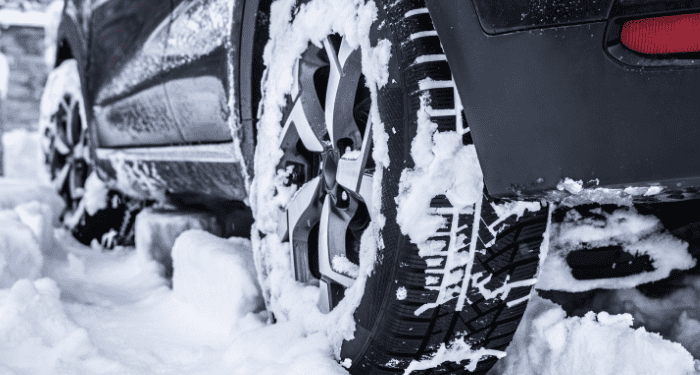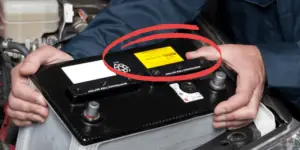Many issues affect your car in winter; the three most common concerns are having a flat battery, not having hot air coming out of the blower, or deciding to put winter tires on your car.
Brakes do freeze in winter, Snow and water can penetrate your brake pads and rotors while you’re driving. If the temperature falls below 32°F, it may freeze, causing the brake fluid to freeze and cause your brakes to stick.
What Causes Brakes To Get Stuck in The Cold?
There are two causes.
Firstly, there is moisture in your brake system, especially if you have driven in the wet or in the snow. Snow on the brakes will be heated up as you use them and turn to water. Unfortunately when you park again and leave your vehicle for a few hours that water will freeze.
In severe colder periods, the water can freeze the brake calipers – these are the parts that hold your pads and push them against the rotor – stuck.
Your brakes work by utilizing hydraulic brake fluid when you press the brake pedal. Without this being part of the system, it would take more force than a human could ever muster to press on the brake pedal to stop the car.
As with any fluid – brake fluid is no exception – it has a freezing point.

Luckily the freezing point is a low, low -40 celsius which is also – 40 Fahrenheit! Unfortunately, dirty brake fluid can have water circulating within it – moisture seeps in through the seams in your car’s brake lines – this raises the freezing temperature a few degrees.
Most manufacturers recommend that brake fluid is changed every 24,000 miles or two years, whichever comes first – for this very reason.
This fluid change often gets overlooked when the DIY mechanics service their own cars, but in states with harsh climates, it’s a service schedule that should be maintained.
How Many Car or Truck Brake Fluids Are There?
Brake fluid is heavily tested and regulated by the Department of Transportation. It’s a vital component in ensuring car brakes do their job when the brake pedal is pressed. So this makes sense.
There are three types of brake fluid. Each starts with a prefix DOT – yep, it stands for the Department of Transport!
We have DOT 3 and DOT 4 – I’ve put these together on purpose, and then we have DOT 5.

DOT 3 and DOT 4 are glycol-based fluids, which means even when it absorbs water – which it will – it can still do their job reasonably effectively. However, the more water within it, the less effective the fluid will become.
Then we have DOT 5, which is a silicone-based brake fluid. The big difference here is that silicone doesn’t absorb water – that’s why it’s often used as a restroom sealant- which sounds great. You might wonder why we need DOT 3 and 4 if DOT 5 does a better job.
Unfortunately, DOT 5 is rarely recommended as it does not work well with ABS, which almost all cars have now.
My Parking Brake Is Frozen But Brakes Are Working
Yes, this can happen. In some cars, the handbrake or parking brake is entirely separate from the usual brake circuit and only works on the car’s rear wheels compared to the brake pedal, which engages brakes on all four wheels.
It can be frustrating to press the brake pedal to the floor but not be able to release the handbrake to get your car out of park.

On older cars with a cable handbrake system, moisture can freeze on the cable, which prevents it from moving when you release the handbrake or move out of park. An electronic handbrake is fitted in modern cars, which removes the likelihood of the handbrake freezing stuck.
Action To Take If Your Brakes Are Frozen
Parking Brake Frozen
It’s more likely your parking brake has frozen than your driving brakes.
Here are some suggestions that may free them up and get you back on the road.
- Start the engine and leave the car idling. Often the warmth generated from the engine will thaw the ice under the hood but also gently warm the rest of your car too. After ten minutes try and release the parking brake. You may have to try this over the course of another 10 minutes as it may take several attempts to free the ice.

- A hairdryer is a great tool for thawing out frozen car doors but also great for thawing out brake cables. The handbrake cable runs to the rear wheels so you may have to get under your car and heat up the ice from there. If you haven’t got an extension lead for a hairdryer or don’t have a hair dryer at all you can still work on the cables with a hammer – gently though – to get rid of the ice.
- If you feel like a workout you could try rocking your car back and forward and from side to side. Unlikely to work but some people have been lucky doing this.
- Not recommended but people often do this in desperation. Drive off with the handbrake on. Often if the brakes are iced up and you have to be somewhere quick you can just drive – very slowly – for a few feet to see if the ice frees up. Often times you’ll hear a clunk and that’ll be the ice being dislodged. You could cause damage to the cable if you attempt this but may feel it’s worth the risk.
How To Prevent Brakes Freezing?
- Don’t use the parking brake at all. Simply leave the car in gear instead. If you’re facing downhill, leave the car in reverse. If you’re facing uphill leave it in a forward gear.
- If that doesn’t work then there is likely to be a mechanical fault with your handbrake. This can be a corroded drum that has let moisture in which seizes the handbrake in place or a cable that needs replacing.




![How Fast Can You Go With Chains on Your Tires? [Answered] snow-chain-frozen](https://carzaza.com/wp-content/uploads/2023/12/snow-chain-frozen-300x150.png)








